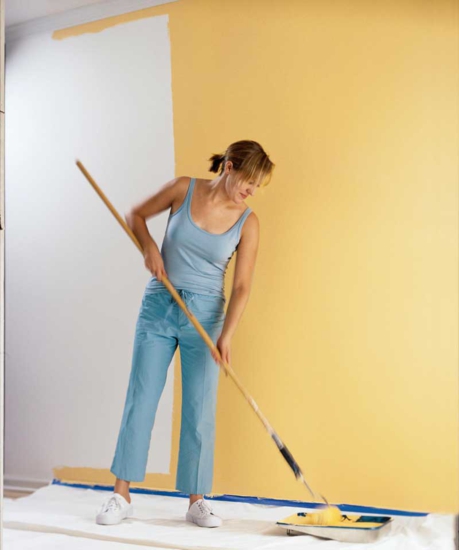Whether you’re redecorating or not, every room of the house can use a fresh paint job sooner or later. If your plan is to DIY, don’t get to work until you’re sure you’re ready. Any room that is about to be painted needs to be prepped for the job. Here’s how to do it.
Clear the Space
To begin, take everything you can out of the room you’re going to paint. Take hanging off the walls, remove curtains, remove area rugs, take out any furniture that you can, remove light fixtures, and get out as much as possible of the things you wouldn’t want to paint accidentally. Also unscrew the light switch and outlet covers. For the furniture that’s left in the room, move the pieces and huddle them together in the center of the room so that you have as much open space as possible near the walls.

Scrape If Necessary
If anywhere in the room the current paint has begun to chip or peel, you’ll need to gently scrape them off. Sand the area so it blends in with the rest of the wall. If your home is more than 30 years old, do not scrape the paint until you test for asbestos. You can buy a testing kit at your local hardware store. If positive, you’ll need to hire professionals to do the dangerous job.
Clean the Walls
You want to apply paint to a clean surface, so you need to clean the walls. With a large sponge and some warm, soapy water, simply wipe down the entire room. Use two buckets so that you can rinse the dirty sponge off in one before getting it wet again and reusing it, so you don’t spread dirt.
Use Painter’s Tape
Now is the time to tape the room so that you can paint without worrying too much about making straight lines or keeping paint off of certain surfaces. First go around the entire floor and entire ceiling of the room and putting down tape in straight lines; use a level if you need help making them straight. Then go around windows and door frames. Tape any other areas that you don’t want to paint.
Use Drop Cloths
You will also need several large drop cloths or tarps to further protect the area from spilled or splattered paint. Place drop cloths so that they cover the entire floor. If any furniture is in the middle of the room, use a drop cloth to cover it all up and further protect it.
Set Up Lighting
Proper lighting is crucial when you’re painting a room. It can be difficult to see fine lines and edges, and it’s see the color of the paint. You may need to bring in additional lighting, like tripod lighting, but any bright lights will do. Try to aim lighting at the corners of the room and illuminate as much of the space as possible. Never try to paint in the dark!
Lizel S is working on creating DIY kits to build a vanity for the bathroom. She is a huge fan of easy projects and loves to share ways to do things better.

